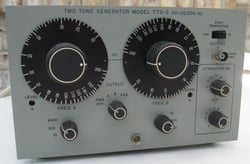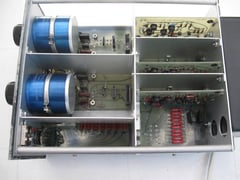Vintage Audio: Singer TTG-3 Two-Tone Audio Generator | Telos Alliance
By The Telos Alliance Team on Sep 7, 2016 1:15:00 PM
 Vintage Audio: Singer TTG-3 Two-Tone Audio Generator
Vintage Audio: Singer TTG-3 Two-Tone Audio Generator
Many of the items featured in Found in the Attic are familiar staples of the broadcast, test equipment or consumer electronics industries. But sometimes we feature the obscure. This is one of those times, as we revisit a college surplus grab from the 1970s, and look at the Singer Two-Tone Audio Generator Model TTG-3.
Part of what makes this device obscure is that it wasn't designed as a stand-alone piece of test equipment. Rather, it was a plug-in component of the Singer Panoramic Model SSB-50 Single Sideband Analyzer System. Since it is a two-tone generator, it could be used for single or two-tone modulation of single-sideband transmitters, intermod distortion tests, harmonic distortion tests, and general troubleshooting.
Frequency range is 20 to 20 Khz in three decade ranges. A calibrated attenuator enables outputs from +10 to -60 dBm in 1 dB steps. Output can be selected from tone A, tone B, or tones A and B algebraically summed. Output impedance is 600 ohms, unbalanced. Harmonic distortion products are at least 60 dB below output signal level. The TTG-3 is organized on four printed circuit boards, a motherboard, two audio oscillators and the summing amp. An extender board is available for troubleshooting and service, although none came with this particular unit.
The oscillator is a conventional bridged T device with four stages of amplification and two feedback loops. A thermistor in the feedback network compensates for component aging or variations in supply voltage.
The output of the selected oscillator is connected through the OUTPUT selector switch to a resistive summing network and a tweak to calibrate the output to +10 dBm at 1 Khz. From there it goes to difference amplifier an on to subsequent stages of amplification. The output of the summing amp connects to a 60 dB decade attenuator.
Oddball pieces of electronic equipment such as the TTG-3 were common finds at college surplus grabs. These programs included the Western Electric College Gifts Program, and similar programs by HP, Teradyne and others. The biggest supplier of surplus electronics, not surprisingly, was the federal government. They were a blessing to college physics and electronics labs, and peaked from the mid- 1960s to the late 1970s. This was the time when government contracts for military electronics and NASA flowed like water. It was also a period of rapid advances in electronics technology, from tubes to transistors, from point-to-point wiring to printed circuit boards, from analog to digital.
In many government agencies, it was more expedient simply to replace broken equipment rather than repairing it. So off it went to surplus warehouses across the country for disposal to non-profit organizations, largely colleges and universities.
Once an organization was registered with the program, representatives could visit as often as they liked, and everything was first come, first served. Equipment had a disposal tag which listed (among other things) AC (Acquisition Cost), what the government paid for the item, and SC (Shipping Cost), what it cost to ship it to the warehouse, and what the customer paid. Typically, this was pennies on the dollar.
There were a few catches. Most of the equipment was either not working at all, or had 'issues'. There was no way to test it. Manuals were rarely, if ever, included. Sometimes key components such as plug-in modules, specialized connectors, plugs or adapters were missing. Most of the time, the equipment was on pallets, and you had to buy everything on the pallet, and take it all with you.
The pallet system was the way the government got rid of junk. Often there would be a nice Tek oscilloscope and HP signal generator on a pallet with a couple OS-8 scopes with broken CRTs and an Army mobile communications transceiver that had been run over by a tank. You had to take it all.
Getting this equipment back in working condition and calibrated provided a great education in research, troubleshooting and applied electronics, as well as sheet metal work, when one had to fabricate covers and other missing cosmetic items. Occasionally, a few swift blows with a rubber mallet were necessary to get chassis parts back in alignment.
Getting manuals before the days of the internet could also be challenging. Tracking down the smaller companies and contact info usually entailed a trip to the library to research them in the Thomas Catalog. Some companies would be very helpful and send manuals out to colleges for free, others would sell them, and a few didn't want to bother with phone calls or letters from people who didn't work for the government. Oftentimes these smaller companies merged, were bought out, changed names, or just went out of business, making the task even more difficult.
This TTG-3 arrived with a quality control tag on the front. Checked were the boxes that said 'failed final QC inspection' and 'discard'. Despite the fact that it failed QC, it had warranty seals on the chassis. Strange. No service manual was available at the time. Tracing back from the plug-in connector, it was clear the TTG was powered by a bipolar supply. Four 9-volt batteries were lashed together to form an 18-volt supply. Output was monitored on a scope, only there was no output. Voltage measurements at transistor junctions seemed reasonable.
Further investigation led to the frequency dials. Something didn't feel right as they were turned. The dials connect to two-gang potentiometers. Removing the retaining ring between the two sections revealed the problem. The linkage had not been joined, so only the first section rotated till it hit the stop of the rear potentiometer. Joining the two sections made things right, but the oscillator still wouldn't work.
Since the oscillators were on removable PC boards, the next step was checking components, starting with resistors. Bingo. A 180-ohm carbon composition resistor on both boards measured around 400 ohms. Replacing these yielded an operating two-tone generator. This generator features a lot of premium-quality mil-spec components, but most of the resistors are 1/4-watt carbon composition devices, subject to drifting out of tolerance with the passage of time and exposure to high humidity. In this case, it appears that a bad batch of 180-ohm resistors was used when these oscillators were assembled.
Further experimenting determined that the two tweaks for each oscillator on the motherboard were for dial calibration. A bit more work with these brought the calibration well within the specified +/- 3 percent accuracy.
Once the TTG was running properly, a permanent bipolar 15-volt supply was attached to the back and it became the bench audio generator. Many years later, a service manual was downloaded off the internet.
The Singer Company started out in 1851 as a manufacturer of sewing machines. In the 1960s, it diversified, acquiring several electronics manufacturing firms, including Panoramic (known for its line of spectrum analyzers), Packard Bell Electronics, and General Precision Instrument Corporation. In 1987, the company was the subject of a hostile takeover by corporate raider, Paul Bilzerian. To recover his investment, he quickly sold off most of the divisions.
Singer briefly entered the broadcast equipment market when it purchased the Visual Electronics AM-FM product line, and operated under the name Sintronics. Somewhere along the line, the name went back to Singer. The company ran into financial difficulties, and sold out to CCA Electronics in 1974.
This TTG-3 has given flawless service from the mid-1970s until today. Recently, the dial calibration went south, and that problem was traced to a few more of those pesky carbon composition resistors going out of tolerance.
Telos Alliance has led the audio industry’s innovation in Broadcast Audio, Digital Mixing & Mastering, Audio Processors & Compression, Broadcast Mixing Consoles, Audio Interfaces, AoIP & VoIP for over three decades. The Telos Alliance family of products include Telos® Systems, Omnia® Audio, Axia® Audio, Linear Acoustic®, 25-Seven® Systems, Minnetonka™ Audio and Jünger Audio. Covering all ranges of Audio Applications for Radio & Television from Telos Infinity IP Intercom Systems, Jünger Audio AIXpressor Audio Processor, Omnia 11 Radio Processors, Axia Networked Quasar Broadcast Mixing Consoles and Linear Acoustic AMS Audio Quality Loudness Monitoring and 25-Seven TVC-15 Watermark Analyzer & Monitor. Telos Alliance offers audio solutions for any and every Radio, Television, Live Events, Podcast & Live Streaming Studio With Telos Alliance “Broadcast Without Limits.”
More Topics: Vintage Electronics, Vintage Audio Technology
Recent Posts
Subscribe
If you love broadcast audio, you'll love Telos Alliance's newsletter. Get it delivered to your inbox by subscribing below!